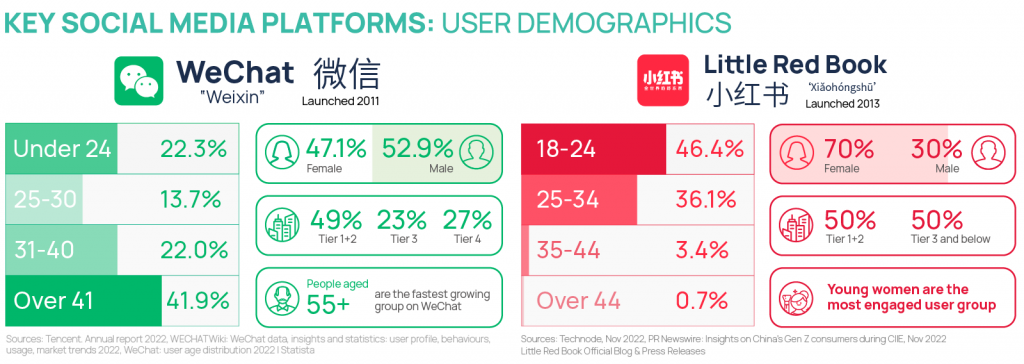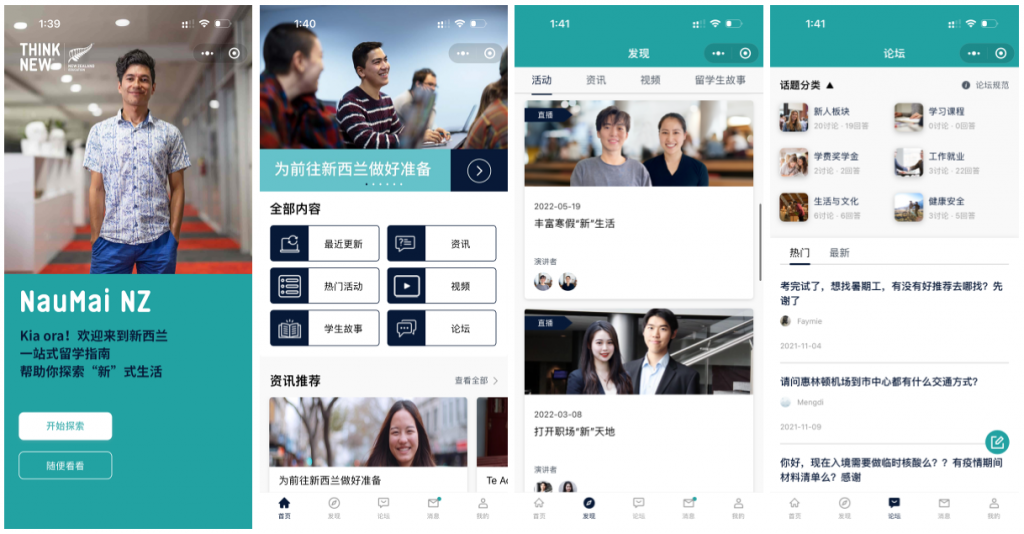We all know students are totally immersed in the digital world. It’s the world of Instagram, Facebook, TikTok (Douyin in China), WeChat, and Little Red Book—a mobile-first, always-on, highly visual, social, and interactive world.
UMS has delivered a range of student experience solutions for this digital world. We have learned a lot and believe there’s a significant opportunity to improve the student experience on campus by combining digital expertise with insights from behavioural science.
Here are five ways digital solutions for Chinese students can improve their experience and benefit your organisation:
1. Improve engagement
Chinese students are much less likely to visit websites or use Western social media such as Facebook and Instagram. WeChat is their starting Point. Little Red Book (“Red”) and Douyin are also extremely popular (for more insight, see our guide China Social Media Platforms Report.
Connecting with your Chinese students in their digital world and language will increase engagement and positive student experience outcomes. For example, WeChat Mini Programs provide Chinese students with a familiar and easy way to access information, video, and tools (e.g. planning and health) and join live streaming.
Additionally, using Chinese social media platforms for student experience makes it easier for you to use the wider Chinese digital ecosystem to source new student users, drive repeat visitation, and grow sharing and advocacy.
2. Support your largest student group.
Chinese students are usually the most significant international student cohort in key English language markers, including the UK, US, Australia and New Zealand.[1] Leading universities often have over 40% of their international students from China. However, in some countries and institutions, the overall student experience ranking for students from China is lower than the international student average.[2]
Developing tailored digital solutions for Chinese students enhances their experience while demonstrating your institution’s commitment to this vital student group. This will help increase retention and advocacy, especially on Chinese social media, where students feel at home sharing their experiences.
It also helps an institution and the broader destination market protect revenue. Chinese students are often the largest source of international fees, and the group is most likely to move from school to undergraduate and postgraduate study within the same country.
3. Equip your students to tackle their most pressing challenges.
Multiple studies note the challenges experienced by many Chinese students around cultural integration, making friends with those from the host country, language, and adaptation to a different educational approach[3].
Digital solutions give you the opportunity to support students around these challenges in a safe, private, and non-threatening way. Information alone is usually not the solution. Giving students access to self-directed tools, student stories to normalise the issue and provide tips, steps for action, online support groups, forums, and other services can all enable students to take positive steps.
Insights and techniques from behavioural science can help “nudge” students to action or increase knowledge, even if they’re not actively seeking information or help.[4]
4. Increase positive word-of-mouth
Using digital solutions to help improve student experience will provide another benefit – increased word of mouth. Chinese students, in particular, rely on word of mouth for decision-making and peer-to-peer advice while studying in a country.[5]
Social media, such as WeChat, spreads and amplifies word of mouth. Many studies place friends, parents and teachers individually in the top 3-4 sources of information.[6]
A recent student experience study by Education New Zealand has Chinese students rating friends as the most important group for support, at 72%, and 5 percentage points higher than the total sample.[7]
5. Support your other international student services
Higher education providers offer many services to international students. However, often, these services are resource-intensive (student support staff and counsellors), moment-in-time (orientation week), or require students’ effort (travel, time, and money).
Digital solutions can scale and reach a wider audience than face-to-face services. They can also be more engaging, interactive, and adaptable to an individual student’s needs than a printed handbook that goes out of date quickly.
Various digital solutions can also help prepare or support students before a face-to-face meeting. It can be helpful to develop an “online to offline” strategy for student experience. This will let you reach a wider student audience while helping channel them to your other services.
UMS has extensive knowledge in international education globally and helping to improve student experience. Many of our team are former international students. They know both the challenges and transformational experience of studying abroad.
For two examples of our student experience digital solutions, see the following case studies:
UMS delivered a Chinese version of the Education New Zealand international student experience website called NauMai NZ, as a dedicated WeChat Mini Program, enabling students to share and learn from each other.
UMS is keen to help you develop a digital strategy for your international student experience needs and to support your current on-campus activities.
Talk to us now to learn more. Contact sales@ums.co.nz
References
[1] ICEF Monitor, Student Population in Leading Destination, August 2024
[2] Education New Zealand’s International Student Experience Survey 2023
[3] Holliman, Andrew J., Bastaman, Amanda S., Wu, Hiu S., Xu, Shuyue and Waldeck, Daniel. “Exploring the experiences of international Chinese students at a UK university: a qualitative inquiry” Multicultural Learning and Teaching, 2023. https://doi.org/10.1515/mlt-2022-0020
Huang, L., Kern, M. L., & Oades, L. G. (2022). Experiences of Chinese international students living in Australia: Wellbeing from “we” to “me”. International Journal of Wellbeing, 12(3), 81-100. https://doi.org/10.5502/ijw.v12i3.1915
[4] For a discussion of international students’ information seeking, see Chang, S., & Gomes, C. (2017). “Digital Journeys: A Perspective on Understanding the Digital Experiences of International Students.” Journal of International Students, 7(2), pp 352-353. https://doi.org/10.32674/jis.v7i2.385
[5] See “The Student voice matters in determining choice of University or College”, p26, UCAS and Pearson, Global Insights: What are the experiences of Chinese students in the UK, 2023.
[6] For example, see UCAS and Pearson (above), p 24.
[7] Education New Zealand, 2023 International Student Experience Survey 2023,
















